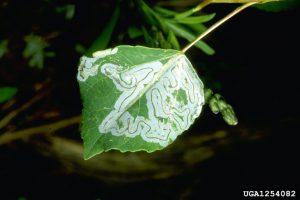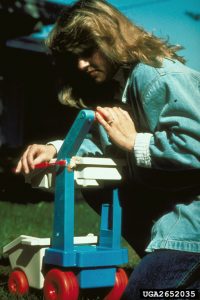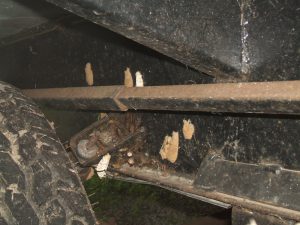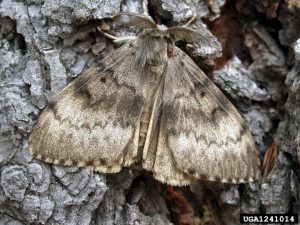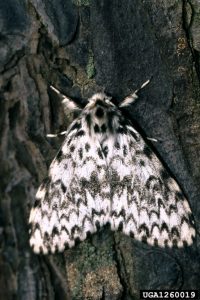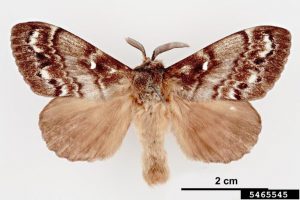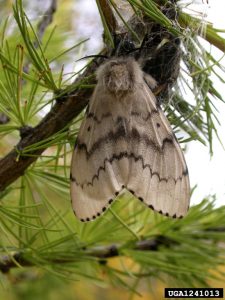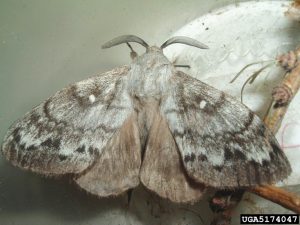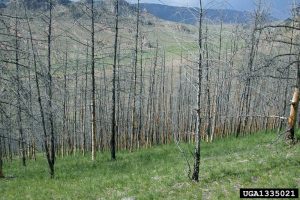Learning Objectives
- To learn what defoliating moths are and how they damage trees.
- To learn common defoliating moths.
- To learn signs and symptoms of defoliating moth activity.
- To learn potential defoliating moth threats to Alaska.
- To become familiar with the vocabulary of defoliating moths.
What are defoliating moths and how do they damage trees?
Defoliators are any pest whose action results in the loss or absence of leaves or needles from a plant. Defoliators are found on a variety of host plants and feed on leaves in a variety of ways. Damage from defoliating insects can vary in severity depending on the pest, plant host, and even the time of year that the feeding occurs. Several groups of insects may be considered defoliators. Defoliating moths are moths whose larvae feed on leaves or needles of plants.

Autumnal moth feeding on alder leaves. Photo by Michael Rasy, University of Alaska Fairbanks-Cooperative Extension Service
Defoliation is the loss of foliage (leaves) from a plant. Leaf loss may be a natural event for some plants, such as deciduous trees losing their leaves in the fall. However, leaf loss at the wrong time or under atypical circumstances stresses trees and can lead to mortality in severe cases. Leaves are the primary source of food and energy for plants. Leaf loss reduces a plant’s ability to photosynthesize and feed itself. This can result in reduced or stunted growth, twig and branch dieback, mortality in small feeder roots, or tree death. The stress of defoliation can also make a tree more susceptible to other pests (insects or disease) that may ultimately be responsible for the tree’s death.
The impact defoliation has on trees is influenced by several things:
- The tree’s overall health
- The severity of the defoliation
- The timing or frequency of defoliation
Initial tree health plays an important role in protecting trees from all kinds of pests. Healthy trees are more resilient to the damage caused by pests. In some cases, an otherwise healthy tree is able to use its energy stores to produce new foliage or may be able to get by with the leaves it has left until the next season’s normal leaf production cycle.
Virtually all trees and plants suffer some defoliation during the growing season. Usually this is minor and does not adversely affect the tree. Less than 50% loss is usually tolerated without major declines in the vigor of the tree. More than 50% loss can result in more serious declines in tree health through growth reduction or weakening due to the use of food stores for refoliation.
The timing and frequency of defoliation can also influence how severely the tree is affected. Defoliation early in the growing season is most detrimental because the tree has just expended a lot of energy into budbreak and leaf expansion, but has not yet had time to replenish food reserved through photosynthesis. Refoliation often occurs after such early season defoliation, but it is additionally stressful to the trees. Late season defoliation is usually less harmful because the leaves have already made and stored excess food supplies. One defoliation event, even if it is heavy, is tolerated by most otherwise healthy deciduous trees. Consecutive years of defoliation are more harmful and can lead to tree death.
Deciduous and evergreen trees respond to defoliation in different ways. Deciduous trees are a little more resilient than evergreens to defoliation events. While a deciduous tree may bounce back from defoliation, a single complete defoliation of an evergreen can be very stressful for a tree.
Defoliation events that occur over large areas of forest, even if they don’t kill trees, can have a variety of ecological or social impacts as well, including positive or negative changes to wildlife habitat, changes to aquatic systems, aesthetic changes, and recreational impacts. It is important to note that defoliation occurs to some degree on all plants. Low levels of defoliation by native species typically have little impact on the overall health of trees or forests. It is large-scale outbreaks or new pests in an area that cause the most concerning damage. New pests can have a higher potential for damage because they often lack natural enemies and are able to exploit the available food sources.

Defoliation off Arctic Valley Road near Eagle River shows the effects of a geometrid moth outbreak in 2011. Photo by Michael Rasy, University of Alaska Fairbanks-Cooperative Extension Service
Defoliators feed in several ways. Leaf chewers consume all leaf tissues including veins, though veins are usually the last thing eaten. These are the most damaging defoliators. Leaf miners feed on succulent tissues between the upper and lower surface of leaves. Skeletonizers are similar to the leaf chewers except skeletonizers do not feed on the leaf veins. The invasive defoliating moths we are concerned about in the context of this module are primarily leaf chewers.
- Leaf chewing damage on a hardwood tree. Photo by Louis-Michel Nageleisen, Département de la Santé des Forêts, Bugwood.org
- Leaf mining damage on an aspen leaf. The silvery areas are where the miners have eaten the chlorophyll from between the upper and lower surface of the leaf. Photo by William Ciesla, Forest Health Management International, Bugwood.org
- Skeletonizer damage. The light colored areas are recently skeletonized. These areas will eventually turn brown and papery. Photo by Lesley Ingram, Bugwood.org
Life history
Moths go through four life stages in order to complete their life cycle: Egg -> Larva -> Pupa -> Adult.
The larvae, also called caterpillars, are the immature stage of the moth and are responsible for the majority of feeding and damage. The larvae are typically gregarious feeders, meaning they feed in large groups. Once the larvae have reached maturity, they will move to a protected place (the soil, under a bark crevice, etc.) to pupate before emerging as adults and starting the process again.
Host preferences of moths are dependent on the species of pests; however, unlike the bark beetles and wood borers, defoliating moths tend to be highly polyphagous. For instance, the Asian gypsy moth, will feed on more than 500 species of trees and shrubs within 100 plant families. In contrast, the invasive European spruce bark beetle prefers spruce trees but will feed on other related species within the Pine family.
Signs and symptoms of defoliating moths
When we talk about signs and symptoms in forest health, we are referring to the clues used to help diagnose a tree health problem.
Signs are physical evidence of the pest itself. Examples of signs include:
- Insect or animal evidence
- Holes in bark or chewed in leaves
- Frass
- Actual insects present causing damage
- Fruiting bodies of fungi
- Conks
- Mushrooms
- Bacterial ooze
Signs of defoliating moth activity include:
- Loss of leaves or leaf tissue from the tree
- Presence of frass beneath the tree canopy
- Actual insects (any life stage)
- Caterpillars feeding on leaves. These particular pests also make webs around leaves which can also be a sign of their presence. Photo by William M. Ciesla, Forest Health Management International, Bugwood.org
- Caterpillar frass. Frass can accumulate under the plant, on the leaves, or on other parts of the plant where it may get stuck. Photo by Whitney Cranshaw, Colorado State University, Bugwood.org
Defoliating moths may be one of the easier groups of insects to observe and identify because they are comparatively large and feed externally.
Symptoms are the plant’s response to a pest. Examples of symptoms include:
- Leaf discoloration, spots, or distortion
- Branch dieback
- Stem lesions
- Galls
- Dead stems
Symptoms of defoliating moth activity include:
- Reduced tree growth
- Twig or branch dieback
- Thinning of the canopy

Branch dieback in an ornamental tree. Note the lack of leaves at the tips of the top branches. Photo by Joseph OBrien, USDA Forest Service, Bugwood.org
Symptoms of defoliating moth activity may be more subtle than symptoms of other pests and may need to be observed over several growing seasons. It is likely that signs of defoliating moth damage will be evident before the symptoms.
Symptoms for multiple pests/disorders can be similar. Never confirm a diagnosis on symptoms alone!
Invasive defoliating moths
Invasive defoliating moths can be easily moved from one place to another. The most significant pathway for introduction of invasive defoliating moths is ships and cargo from the moths’ native ranges. Female moths are attracted to ship and port lights and will lay eggs on non-host material including ships, shipping containers, timber, rail cars, and vehicles.
Human movement of infested items such as firewood and recreational vehicles contributes to the spread of these moths once they are established in an area. Any item stored outdoors could potentially have eggs laid on it.
- Egg masses and female moths on a child’s toy. Photo by USDA APHIS PPQ, USDA APHIS PPQ, Bugwood.org
- Check truck or car undercarriage for egg masses. (Vince Burkle, Indiana IDNR)
Several invasive defoliating moths threaten Alaskan forests. While none are currently established in Alaska, there have been several detections and interceptions since coordinated trapping efforts began in 1983. Because of our proximity to the Asian continent, Alaska currently traps for defoliating moths of Asian origin as part of nationwide surveys for invasive moths. The particular species of concern include the Asian gypsy moth (Lymantria dispar asiatica), rosy gypsy moth (Lymantria mathura), nun moth (Lymantria monacha), and the Siberian silk moth (Dendrolimus sibiricus). Though not specified in the survey protocol, trapping efforts also target European gypsy moths (Lymantria dispar dispar) because they respond to the same lure as the Asian gypsy moths.
Current moth trapping efforts are managed through the Alaska Department of Natural Resources, Division of Agriculture, Cooperative Agricultural Pest Survey (CAPS) Program. Trapping efforts in Alaska contribute to nationwide surveys for invasive defoliating moths. If you are interested in helping with the trapping effort by setting traps in your area, contact:
Jacquelyn Schade
State Survey Coordinator-Alaska Division of Agriculture
907-761-3858
Jacquelyn.Schade@alaska.gov
- Asian gypsy moth adult. Photo by John H. Ghent, USDA Forest Service, Bugwood.org
- Rosy gypsy moth adult. Photo by David Mohn, Critters Page (Creatures Great and Small), Bugwood.org
- Nun moth adult. Photo by Hannes Lemme, Bavarian State Ressearch Center for Agriculture, Bugwood.org
- Siberian silk moth adult. Photo by Pest and Diseases Image Library, Bugwood.org
Gypsy moths have been positively identified nine times in Alaska since trapping began either through traps or interceptions at ports. The most recent trap detection was for the European gypsy moth (EGM) in Fairbanks near an RV park in 2006. The most recent interception on a cargo ship was of Asian gypsy moth (AGM) egg masses near Juneau in 2014.
European and Asian gypsy moths are both subspecies of a larger species complex. They are difficult to distinguish from each other based on appearance yet are very different in certain aspects of their biology. Both are unwanted invasive species.
| EGM | AGM | |
| Females | Do not fly | fly |
| # of host species | ~250 | ~500 |
Table 1: Comparison of European gypsy moth (EGM) females and host species to Asian gypsy moth (AGM) females and host species
European gypsy moth (EGM) is widely established along the East coast of the United States and west into the Great Lakes states. It is a pest of hardwood trees and has been one of the most destructive invasive pests introduced into North America, often defoliating a million or more acres of forests annually. Aggressive detection and eradication efforts, referred to as “Slow the Spread” have limited the westward movement of this pest in the last decade. Quarantine regulations are also in place to help limit the spread of EGM within the country.
European gypsy moth spreads within the country in a variety of ways. Natural spread occurs fairly slowly since females do not fly but larvae can and will utilize the wind and “balloon” to new trees. Human mediated spread results in a more rapid spread of the pest and is accomplished through the movement of infested firewood, egg masses on cars and RVs, and moving household items such as lawn furniture, yard equipment, or outdoor toys from infested areas to non-infested areas.

This map shows the quarantine area for European gypsy moth in the U.S. and Canada. Map by USDA-APHIS-PPQ. Click on image for larger view.
The Asian gypsy moth (AGM) is not known to occur in the United States; however, it has been detected in traps and intercepted at ports of entry. In 2015, Asian gypsy moths were detected in several traps in Washington and Oregon prompting aggressive eradication efforts in those states.
AGM poses a greater threat because, as mentioned previously, the females can fly therefore increasing the spread potential, and they have a broader host range, increasing the liklihood of finding suitable food sources. For these reasons, if AGM were to establish, it would be harder to contain than the EGM.
Asian gypsy moth is highly polyphagous and will feed on over 500 species of plants. Main hosts in Alaska include alder, larch, poplar, and willow, but AGM will also feed on apple, birch, spruce, pine, and rose species. This is not an exhaustive list of hosts, it is possible and likely that AGM would feed on other plants not listed here.
- Asian gypsy moth adult. Photo by John H. Ghent, USDA Forest Service, Bugwood.org
- AGM adult female. Photo by John H. Ghent, USDA Forest Service, Bugwood.org
Adult AGM are drab-colored moths. The males and females look different from each other. Adult males have a 1½ inch wingspan and are grayish brown with darker stripes. Adult females can have up to a 3½ inch wingspan and are white to cream colored with darker markings on the wings. Asian gypsy moths are almost identical to European gypsy moth in appearance.

AGM larvae. John Ghent, John Ghent, Bugwood.org
AGM larvae are about ⅛ inch long when newly hatched and approximately 2 inches long when fully mature. The larvae have distinctive rows of blue and red spots, while larval base color can vary from yellow to black to mottled dark gray which is the most common color. They are also quite hairy.

AGM egg masses. Photo by John Ghent, John Ghent, Bugwood.org
AGM females lay eggs in masses and will lay them on pretty much any thing that is stationary. Egg masses are 1½ to 2 inches long and ¾ to 1¼ inches wide. A single egg mass can contain between 100 and 1000 eggs. Egg masses are covered in hairs from the female’s abdomen giving them a buff color and fuzzy appearance. Some of our native species may look similar in the adult or larval stages but few, if any, will be found on such a variety of hosts
The Siberian silk moth, Dendrolimus sibiricus, is not known to occur in the United States, nor has it been detected here. Siberian silk moth is primarily a pest of conifers and has been found to develop on all of the coniferous species found in its native range. In Alaska, potentials hosts include larch, spruce, hemlock, and fir.
The Siberian silk moth life cycle can vary, and is commonly between 2 and 4 years depending on population density. This can result in rapid population increases if adults from two generations emerge in the same year. Outbreaks can affect several million acres and mortality can reach 100% in severely attacked stands. An outbreak between 1999 and 2002 in Russia damaged approximately 20 million acres of larch stands. Outbreak cycles tend to collapse after 2 to 3 years.
- Siberian silk moth adult male. Photo by Natalia Kirichenko, Bugwood.org
- Siberian silk moth defoliation in Mongolia. Photo by John Ghent, John Ghent, Bugwood.org
Adult Siberian silk moths vary in color from light brown or gray to dark brown to black, depending on geographic origin. The front wings have two characteristic dark stripes and a white spot is on the center of the front wing. They are rather large moths with the female having a wingspan of 2¼ to 3⅛ inches while the male has a wingspan of 1½ to 3⅛ inches.

Siberian silk moth larvae. Photo by John Ghent, USDA Forest Service, Bugwood.org
Larvae are hairy with distinctive blue bands of hairs behind the head. Mature larvae can be between 2⅛ and 2¾ inches long though they have been found as large as 4¼ inches long.

Siberian silk moth eggs. Photo by John Ghent, USDA Forest Service, Bugwood.org
Eggs are laid in clusters on needles, twigs, or branches, usually in the lower part of the crown. They are initially light-green when laid, then turn creamy white then darker when mature.
In addition to the pathways of spread for gypsy moth species, Siberian silk moth may be transported on cut flowers, cut branches, or live plants.
Scouting for invasive defoliating moths
When assessing tree health there are some things to keep in mind that could help to find or identify invasive defoliating moths early. For defoliating moths, look for signs and symptoms throughout the summer.
Eggs/Egg masses: In the forest, AGM or EGM egg masses can be found anywhere from the leaf litter to the tops of trees; however, most are laid on trees in protected areas such as bark crevices. In residential areas, egg masses may be found in woodpiles, rock walls, or landscape trees. Siberian silk moth egg masses can be found on twig and branch ends near foliage, usually in the lower portion of the tree. In high populations, egg masses can be found throughout the tree. Be especially observant of new plantings and nursery stock that may have come from out of state.
Larvae: Larvae can be found feeding on leaves. Larvae may also be noticed when they are moving from tree to tree or by the presence of frass beneath the canopy. At low populations. larvae may be more concealed and difficult to notice. Check upper and lower leaf surfaces as much as possible and new growth early in the season.
Defoliation: Defoliation could be noticeable at any time during the growing season. Look for partially or entirely missing foliage and defoliation on multiple species of plants.
Reporting and submitting specimens
If you find insects that you do not recognize as native pests, it is best to collect the specimen and submit it for identification. Insects are quick and can be elusive. If you don’t think you can capture the specimen, try photographing it. For physically collected specimens, please kill them before submitting for identification.
Insects can be killed by placing them in the freezer for a night or two or by drowning them in alcohol (70% rubbing alcohol will work). Insects can then be placed in a tightly sealed, sturdy container and brought or mailed to your local Cooperative Extension office.
Please group specimens by the location/tree they were collected from. Do not put specimens from different locations in the same container. Please include collection information with each container submitted.
An important aspect of insect specimens that people often forget is the importance of collection information. When you collect a specimen, please make note of the following data:
- Location information – Country, state, location
- Latitude/Longitude – If possible collect this with a GPS unit and include +/- accuracy. If you do not have a GPS unit, a physical address is second best.
- Habitat description, host plant, collection method used (e.g. hand collected, sweep net, trap)
- Date and collector
Example:
- USA: Alaska: Anchorage
- 61.205825, -149.88631 +/- 10m
- Ornamental landscape, lilac shrub, hand collected
- 13JUL 2015 M.J. Moan
If you do not have physical specimens, photos of insects or suspicious damage are welcome and can be submitted through our online Pest Portal or to uaf-foresthealth@alaska.edu
Digital photos can be great tools for insect identifications. Keep in mind, though, that photos are not without their limitations. The tips below can help improve the likelihood of getting an accurate and quick diagnosis when submitting digital photos.
- Check photos for clarity before submitting
- Submit original, unedited photos
- Include a size reference in your photo (coins and pencils/pens work great if you don’t have a ruler available)
- Include as much information about the subject as possible
- Include the same collection information as if you were submitting a physical specimen.
Summary
- Defoliating moths are moths whose larvae feed on leaves and needles of plants.
- Defoliation damages trees by removing or damaging the leaves, the photosynthesizing parts of the trees.
- Defoliation usually causes little harm to trees but can be devastating under outbreak conditions.
- Invasive defoliating moths are a threat to Alaska’s forests because:
- They lack natural enemies
- Are able to exploit resources
- They have known pathways for introduction
- Signs and symptoms of defoliating moths include:
- Loss of foliage from the trees
- Presence of any life stage of the insect
- Reduced or stunted growth
- Branch dieback
- Invasive moths can reach Alaska through:
- Infested shipping containers
- Live plants for the plant trade
- Items being shipped from infested areas that have been stored outdoors near lights prior to shipping
- Defoliating moth threats to Alaska include:
- Asian and European gypsy moth
- Nun moth
- Rosy gypsy moth
- Siberian silk moth
Large-scale defoliation events are rare, but when observed should be noted and reported to Cooperative Extension, the Alaska Division of Forestry or the US Forest Service so they can be investigated further. (link to contact information for reporting)
Quick guide
Download and print this summary of Defoliating moth information for reference.
Vocabulary
- Deciduous: refers to trees or shrubs that lose their leaves annually, usually in the fall
- Defoliating moth: A moth whose larvae feed on the leaves or needles of trees and shrubs.
- Caterpillar: Common term for the immature stage of a moth or butterfly,
- Frass: Insect excrement
- Galls: Abnormal growth of plant tissue
- Larvae: immature stage of some insects.
- Chlorophyll: the green pigment in plants that is responsible for the absorption of light, contributing to photosynthesis.
- Photosynthesis: the process used by plants to convert light from the sun to energy that can be used by the plant.
- Polyphagous: able to feed on a variety of food sources.
- Signs: physical evidence of a pest.
- Symptoms: a plant’s response to a pest.
- Pathway: the means and routes by which invasive species are imported or introduced into new environments.
Sources and more information
- Furniss, R. L. and V. M. Carolin. 1977. Western Forest Insect. USDA Forest Service Misc. Pub. 1339, 654 pp.
- Dreistadt, S. H. 2004. Pests of Landscape Trees and Shrubs: An Integrated Pest Management Guide. Publication #3359, ANR Publications, University of California, 6701 San Pablo Avenue, Oakland, CA 94608-1239. 501pp.
- Holsten, E., P. Hennon, L. Trummer, J. Kruse, M. Schultz, and J. Lundquist. 2009. Insects and Diseases of Alaskan Forests. USDA Forest Service, Alaska Region R10-TP-140, 246 pp.
- Introduction to Defoliating Insects. 2011. U. S. Forest Service – Forest Health Protection – Rocky Mountain Region. Last accessed February 26, 2016, from http://www.fs.usda.gov/Internet/FSE_DOCUMENTS/stelprdb5347217.pdf.
- McManus, M. L., D. R. Houston, and W. E. Wallner. 1979. Gypsy moth handbook. The homeowner and the gypsy moth: guidelines for control. USDA Combined Forest Pest Research and Development Program. Home and Garden Bulletin. 001-000-03950-4. Last accessed February 26, 2016, from http://www.na.fs.fed.us/fhp/gm/online_info/gm/gmhb.htm.
- Molet, T. 2012. CPHST Pest Datasheet for Dendrolimus sibiricus. USDA-APHIS-PPQ-CPHST.
- Molet, T. 2012. CPHST Pest Datasheet for Lymantria dispar asiatica. USDA-APHIS-PPQ-CPHST.
- Molet, T. 2012. CPHST Pest Datasheet for Lymantria mathura. USDA-APHIS-PPQ-CPHST.
- Molet, T. 2012. CPHST Pest Datasheet for Lymantria monacha. USDA-APHIS-PPQ-CPHST.

